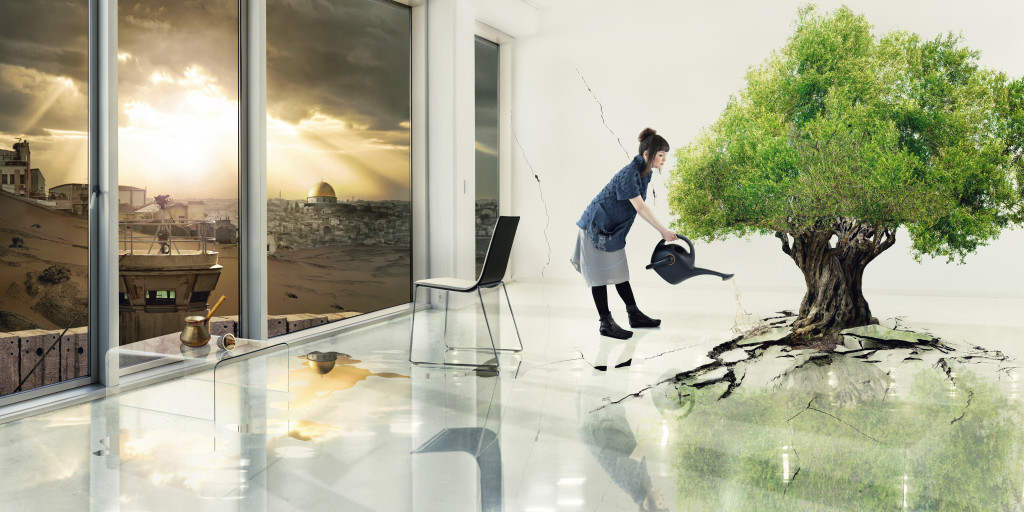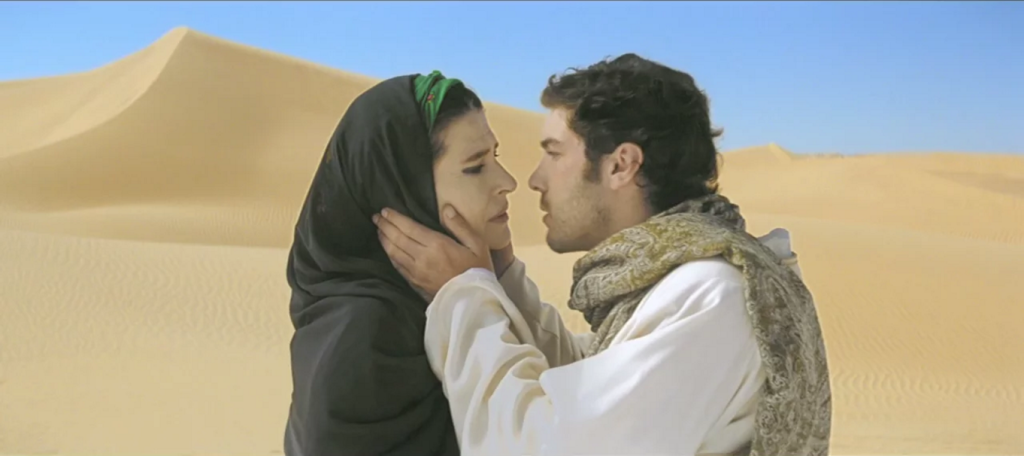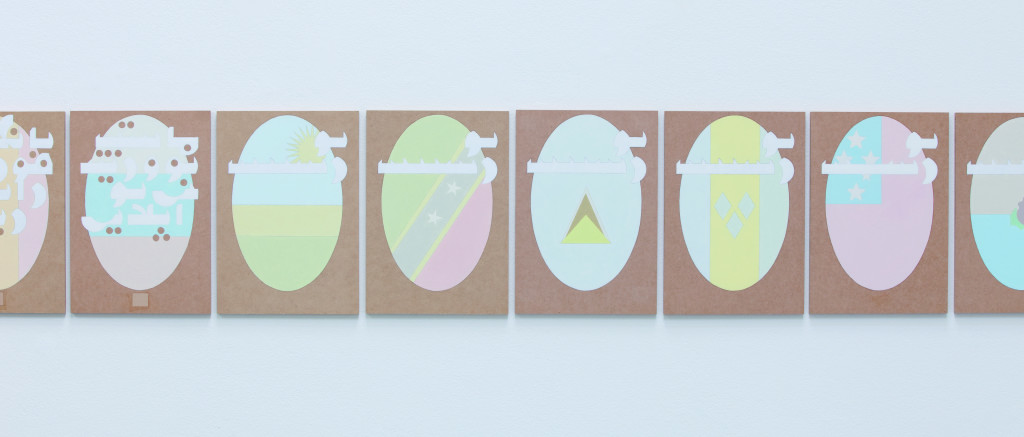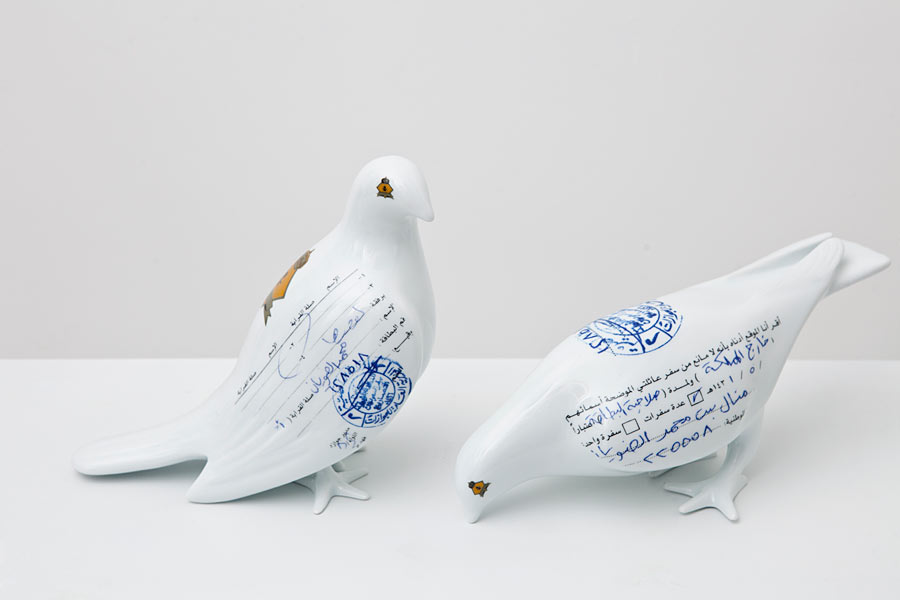Home Ground: Contemporary Art from the Barjeel Art Foundation
by Hiba Ali
Designed by architect Fumihiko Maki in modernist style, the Aga Khan Museum in Toronto, Ontario opened to the public in 2014. Their most recent exhibition, Home Ground: Contemporary Art from the Barjeel Art Foundation, which closed earlier this month, featured twelve artists from the collection whose work depicts the transformative and unsettling aspects of immigration, and the reformation identity within a nation-state. As contemporary political events attest, there has been a mass exodus of refugees from crisis to crisis of many nations including Afghanistan, Syria, Kosovo, Iraq, Nigeria and Somalia in recent years. The people who have left, whether categorized as refugee, immigrant or exile, have all faced the vitriol of xenophobic rhetoric propagated by conservative groups and mentalities. The discourse surrounding nation-states and identity has continued to affect many people globally and unabatedly, irrecoverably changing countless lives and trajectories. Ignoring the initial causes that render these regions unstable silences people who have faced—and continue to live through this hardship—the right to live.

Walking into the Home Ground, Larissa Sansour’s Nation Estate lines the left walls of the gallery, featuring a series of digitally constructed C-prints paired with a nine-minute video. For Sansour, who was born in Jerusalem and lives between London and Copenhagen, the conception of the work critiques the ideological construction of a two-state solution, which effectively locks out Palestinians’ claim to their land. The project’s inception coincides with Palestine’s appeal to the UN for nationhood in 2011—proposing a sci-fi oriented resolution in its place. In the video, Sansour ascends a minimalist elevator in a futurist architectural building; each floor is a replication of well-known Palestinian landmarks and neighborhoods. She goes to her apartment, composed of muted metallic interiors, and warms up pre-packaged food that is heated by the touch of a button. In this futuristic reality, traveling from and to Palestinian neighborhoods are an elevator flight away. However, in present reality, Palestinian neighborhoods are hard to travel from one to another—for work or to visit family, one must undergo oppressive Israeli checkpoints. The satirical replication of neighborhoods in Nation Estate shows this divorced quality, separated from the original, stripped of their history and intrinsic character. At the end of the video, Sansour looks out of her window at the original city of Jerusalem. She holds her pregnant belly with a worried look as the camera pans out to reveal a skyscraper that is enclosed within a larger compound dislocated from Jerusalem separated not only through distance, but also by the ideological infrastructure of the nation-state.

Leaving one’s homeland permanently and perpetually echoes a concern for the future, This sentiment figures heavily in Cairo-born Youssef Nabil’s 10-minute video, You Never Left. In the artist’s own experience of leaving Egypt, for France and then New York, is evoked through visual metaphors by the death, mourning, and rebirth cycle. In the piece, Nabil gives a woman who is wearing a black shroud a kiss intimating a farewell. This action shows that he cares for this person deeply—a signification of the homeland—and is shortly after buried in the dessert, signaling his death. The artist emerges out of a white cloth, an intimation of rebirth, and crawls out to a place where he is surrounded by palm trees and groves. It resembles the Garden of Eden. As he roams the locale, he is greeted by a maternal figure, a type of reappearance, similarly wearing a white shroud. Resting in her arms, the image replicates the infamous Madonna and child pose—a rebirth in a different environment.
Nabil’s journey reflects the experience of the diasporic identity referred to by Stuart Hall in Cultural Identity and Diaspora as “…identity as a ‘production’, which is never complete, and always in process, and always constituted within, not outside, representation.”1 One that gets remade as soon as it is put in contact with different communities and spaces.

In leaving, migrants are thrown into the arms of their prospective hosts. These can potentially be welcoming or non-existent.
Raafat Ishak’s Responses to an Immigration Request from One Hundred and Ninety-Four Governments involves applying for citizenship through 193 recognized governments. Through this, the artist-architect, who was born in Cairo and resides in Australia, explores the constructed notion of home. Ishak inquires if it is based on location or a fabricated sense of identity. In 2001, the Australian government’s ‘Pacific Solution’ prompted the conception for Reponses, which relegated asylum seekers to surrounding islands rather than the Australian mainland. The responses from prospective nation-states to Ishak’s citizenship letter range from acceptance—in referring to their immigration department—to the most popular: no response. Documenting these responses in stylized Arabic script on MDF board, figuring the nation’s flag in the background, the satire laced through the work illustrates the socio-political agency of the nation-state. More often than not, applications like these are left on deaf ears.

Like the earth’s fault lines, which are constantly shifting, so are the spreading of people from one region to another motivated by the will to live and survive. Home Ground reflects on these shifting boundaries—between what is considered ‘home’ by those who migrate, abandon, and recreate their identities in new locales. At the utmost, the exhibition highlights how those who seek safety and a better future navigate the restrictive boundaries of nation-states and seek out strategies to protect themselves at the violent enforcement of the arbitrary lines that we call ‘borders’. Who are these lines harming and whom do they claim to be protecting? Home Ground inspires us to confront the invisible hold of hegemony and power within the nation-state by asking us to consider these egalitarian values—a change that can begin by helping and offering solace to those who need it most.
Hiba Ali is an International Contributor for THE SEEN.